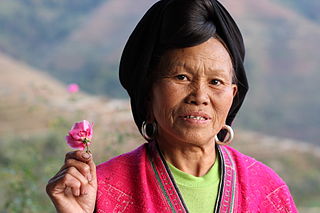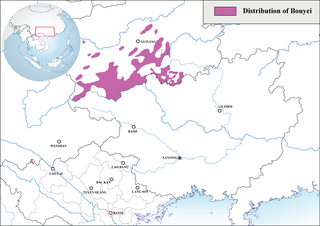
The Kra–Dai-speaking peoples refer collectively to the ethnic groups of southern China and Southeast Asia, stretching from Hainan to Northeast India and from southern Sichuan to Laos, Thailand and parts of Vietnam, which speak languages in the Kra–Dai language family and share some similar traditions.

The Zhuang languages are any of more than a dozen Tai languages spoken by the Zhuang people of southern China in the province of Guangxi and adjacent parts of Yunnan and Guangdong. The Zhuang languages do not form a monophyletic linguistic unit, as northern and southern Zhuang languages are more closely related to other Tai languages than to each other. Northern Zhuang languages form a dialect continuum with Northern Tai varieties across the provincial border in Guizhou, which are designated as Bouyei, whereas Southern Zhuang languages form another dialect continuum with Central Tai varieties such as Nung, Tay and Caolan in Vietnam. Standard Zhuang is based on the northern Zhuang dialect of Wuming.
Gelao is a dialect cluster of Kra languages in the Kra–Dai language family. It is spoken by the Gelao people in southern China and northern Vietnam. Despite an ethnic population of 580,000, only a few thousand still speak Gelao. Estimates run from 3,000 in China by Li in 1999, of which 500 are monolinguals, to 7,900 by Edmondson in 2008. Edmondson (2002) estimates that the three Gelao varieties of Vietnam have only about 350 speakers altogether.

Longlin Pan-Ethnicities Autonomous County is an autonomous county, under the jurisdiction of the prefecture-level city of Baise, in the west of Guangxi, China, bordering Guizhou province to the north.
Qabiao, or sometimes Laqua is a Kra language spoken by the Qabiao people in northern Vietnam and Yunnan, China. Alternative names for Qabiao include Kabeo, Ka Beo, Ka Bao, Ka Biao, Laqua, Pubiao and Pen Ti Lolo. The meaning of the name "Qabiao" is unknown.
The following is a list of the Kra–Dai ethnic groups in China:
Buyang is a Kra language spoken in Guangnan and Funing counties, Yunnan Province, China by the Buyang people. It is important to the reconstruction of the hypothetical macrofamily Austro-Tai as it retains the disyllabic roots characteristic of Austronesian languages. Examples are "to die", "eye", "head", and "eight".
Rauz, Liao, or Lao peoples is an ethnic cluster covering Zhuang, Buyei, Tay–Nùng, and other northern Tai language-speaking peoples. These peoples are inclined to call themselves as Rauz which means "we" or "our people".
The Kam–Sui languages are a branch of the Kra–Dai languages spoken by the Kam–Sui peoples. They are spoken mainly in eastern Guizhou, western Hunan, and northern Guangxi in southern China. Small pockets of Kam–Sui speakers are also found in northern Vietnam and Laos.

Funing County is located in Wenshan Zhuang and Miao Autonomous Prefecture, in the east of Yunnan province, China. It is the easternmost county-level division of Yunnan, bordering Guangxi to the north, east and southeast, and Vietnam's Hà Giang Province to the south.

Malipo County is under the administration of the Wenshan Zhuang and Miao Autonomous Prefecture, in the southeast of Yunnan province, China, bordering Ha Giang Province to the southeast.
The Kra languages are a branch of the Kra–Dai language family spoken in southern China and in northern Vietnam.

Tianlin County is a county in the west of Guangxi, China, bordering the provinces of Guizhou to the north and Yunnan to the south. It is under the administration of the prefecture-level city of Baise.

Yang Zhuang is a Tai language spoken in southwestern Guangxi, China, in Napo, Jingxi and Debao counties.
Paha or Baha is a Kra language spoken in northern Guangnan County, Wenshan Prefecture, Yunnan. The two villages are located near the border with Longlin County, Guangxi. Paha is often considered to be part of the Buyang dialect cluster and is the most divergent form. Although listed in Ethnologue as Baha Buyang, Thai linguist Weera Ostapirat considers Paha to be a separate language.
Bu-Nao, or Bunu proper, is a Hmongic (Miao) dialect cluster spoken in Guangxi, Yunnan, and Guizhou in China. Its speakers are among the Bunu : ethnic Yao (Mien) speakers of Miao languages.
Li Jinfang is a Chinese linguist at Minzu University in Beijing, China. Li, an ethnic Zhuang, is a leading specialist in the Tai–Kadai languages of southern China, especially the Kra (Geyang) branch. Li's doctoral dissertation focused on the Buyang language, and was published as Studies on the Buyang Language in 1999.

The Northern Tai languages are an established branch of the Tai languages of Southeast Asia. They include the northern Zhuang languages and Bouyei of China, Tai Mène of Laos and Yoy of Thailand.
















